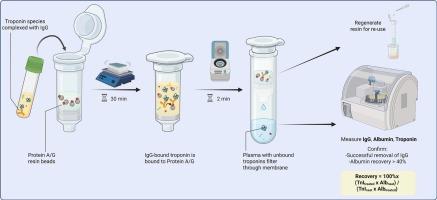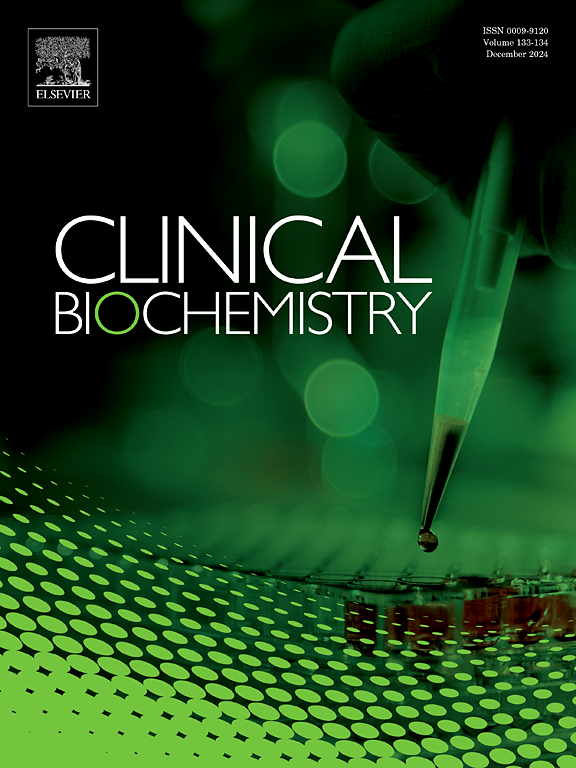Method choice for investigation of macrotroponin interference with the Siemens Atellica high sensitivity troponin I assay
IF 2.1
3区 医学
Q2 MEDICAL LABORATORY TECHNOLOGY
引用次数: 0
Abstract
Objectives
Macrotroponin refers to circulating immunoglobulin-bound cardiac troponin species that may elevate troponin results in patients with or without myocardial injury, causing diagnostic confusion. Clinical laboratories have been recommended to provide a service for troponin interference investigation. We evaluated the applicability of a Protein A/G IgG-depletion procedure as well as polyethylene glycol (PEG) precipitation for detecting macrotroponin interference with the Siemens Atellica troponin I (TnIH) assay.
Methods
Troponin I, IgG, and albumin (internal standard) were measured (Atellica) on the neat and treated plasma to calculate recovery. Reference samples with TnIH ranging from < 1x to > 1000x times the 99th percentile were selected to verify expected recovery. To minimize likelihood of macrotroponin in the reference group, samples with elevated results were only included if recent acute changes in TnIH was documented. 40 samples were used for the IgG-depletion method and 20 for PEG precipitation. 25 samples from patients with unexplained elevation in TnIH were assessed by IgG-depletion.
Results
38 of 40 reference group recoveries exceeded 70 % (median 91 %, IQR 15 %, max 129 %) in the IgG-depletion group consistent with literature on other assays. Specimens from patients with incongruent clinical picture had IgG-depletion recovery median of 11 % (IQR 14 %, max 37 %). PEG-precipitation showed large variation (median 103 %, IQR 89 %, max 227 %).
Conclusions
IgG depletion using Protein A/G can reliably establish IgG-mediated interference with Atellica TnIH. PEG precipitation results are difficult to interpret likely due to matrix effects, especially at values closer to the 99th percentile.

西门子Atellica高灵敏度肌钙蛋白ⅰ检测大肌钙蛋白干扰的方法选择。
目的:大肌钙蛋白是一种循环免疫球蛋白结合的心肌肌钙蛋白,可使有或无心肌损伤患者的肌钙蛋白水平升高,引起诊断混乱。建议临床实验室提供肌钙蛋白干扰调查服务。我们评估了蛋白a /G igg耗尽程序以及聚乙二醇(PEG)沉淀检测大肌钙蛋白干扰与西门子Atellica肌钙蛋白I (TnIH)测定的适用性。方法:用Atellica法测定纯血浆和处理后血浆的肌钙蛋白I、IgG和白蛋白(内标),计算恢复率。选择TnIH范围为 1000倍的参考样品验证预期回收率。为了尽量减少参考组中巨肌钙蛋白的可能性,只有在记录了最近的急性TnIH变化的情况下,才纳入结果升高的样本。40个样品用于igg耗尽法,20个样品用于PEG沉淀法。25例不明原因的TnIH升高患者的样本通过igg消耗进行评估。结果:40个参照组中有38个IgG-depletion组的加样回收率超过70 %(中位91 %,IQR 15 %,最大129 %),与其他测定法的文献一致。临床表现不一致的患者标本的igg耗损恢复中位数为11. %(最小值为14. %,最大值为37. %)。peg -降水量变化较大(中位数103 %,IQR 89 %,最大值227 %)。结论:利用蛋白A/G去IgG可以可靠地建立IgG介导的Atellica TnIH干扰。PEG降水结果很难解释,可能是由于矩阵效应,特别是在接近第99个百分位数的值。
本文章由计算机程序翻译,如有差异,请以英文原文为准。
求助全文
约1分钟内获得全文
求助全文
来源期刊

Clinical biochemistry
医学-医学实验技术
CiteScore
5.10
自引率
0.00%
发文量
151
审稿时长
25 days
期刊介绍:
Clinical Biochemistry publishes articles relating to clinical chemistry, molecular biology and genetics, therapeutic drug monitoring and toxicology, laboratory immunology and laboratory medicine in general, with the focus on analytical and clinical investigation of laboratory tests in humans used for diagnosis, prognosis, treatment and therapy, and monitoring of disease.
 求助内容:
求助内容: 应助结果提醒方式:
应助结果提醒方式:


